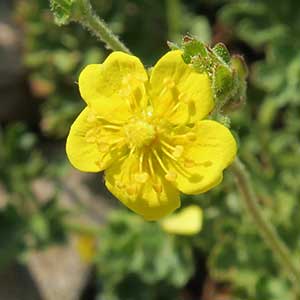Potentilla brevifolia
Rosaceae subfam. rosoideae
short-leaf cinquefoil, sparse-leaf cinquefoil
alternate, rarely opposite, pinnately compound, sometimes simple or palmately compound;
stipules present, rarely absent.
petiole 1–4 cm, eglandular hairs absent or sparse, spreading, less than 1 mm, weak, glands abundant.
epicalyx bractlets lanceolate-elliptic to ovate, 2–4 × 0.8–2 mm;
sepals 3–5(–7) mm, apex broadly acute to obtuse;
petals 3.5–6.5 × 3–5 mm;
filaments 1–2.5 mm, anthers 0.5–0.6 mm;
carpels 10–15.
torus usually enlarged, sometimes small or absent;
carpels 1–260(–450), distinct, free, styles distinct, rarely connate (Roseae);
ovules 1(or 2), collateral (Rubeae) or superposed (Fallugia, Filipendula).
achenes or aggregated achenes sometimes with fleshy, urn-shaped hypanthium or enlarged torus, sometimes aggregated drupelets;
styles persistent or deciduous, not elongate (elongate but not plumose in Geum).
1–1.5 mm.
= 7(8).
Potentilla brevifolia
Rosaceae subfam. rosoideae
Potentilla brevifolia is found mainly in alpine situations in the Pioneer, Sawtooth, Smoky, and White Cloud mountains of central Idaho; the Madison Range of western Montana; the Jarbidge Range of northeastern Nevada; the Blue, Steens, and Wallowa mountains of eastern Oregon; and the Teton Range of northwestern Wyoming. The elongate caudices are easily covered by moving soil and talus.
(Discussion copyrighted by Flora of North America; reprinted with permission.)
Variation in the number of genera in subfam. Rosoideae is due to differences in generic delimitation between D. Potter et al. (2007) and the authors of some Potentilleae genera. Cyanogenic glycosides and sorbitol are absent in the subfamily.
Tribes 6, genera 28–35, species ca. 1600 (6 tribes, 26 genera, 302 species, including 1 hybrid, in the flora)
(Discussion copyrighted by Flora of North America; reprinted with permission.)


